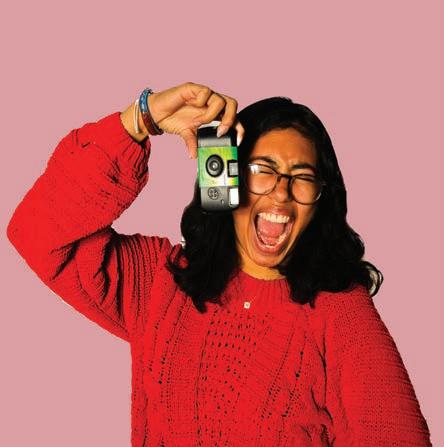


























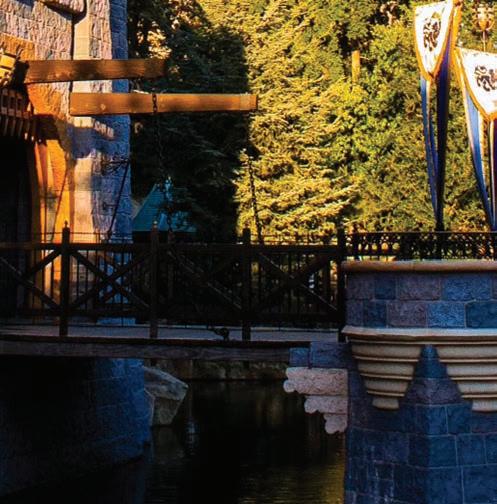


e pursuit of truth: To show students the wide range of experiences life has to o er.
By: Tirza Bustrum
I went home this summer
And dug through a box
Of all the things I’ve kept
All the diaries I’ve locked
All the letters and pictures
My fourth grade class project, Unused stickers and drawings And notes I’ve come to collect
Over years of memories
One stands out from all the rest
A piece of paper
That to me was addressed
I moved to open the fold
And found a jumble of words
Almost unintelligible, it read: “Remember to look at the birds”
Not quite smelling roses
But all the same, I drove a mile
And stopped that day in a park
Watched the birds fly by And mustered a little smile
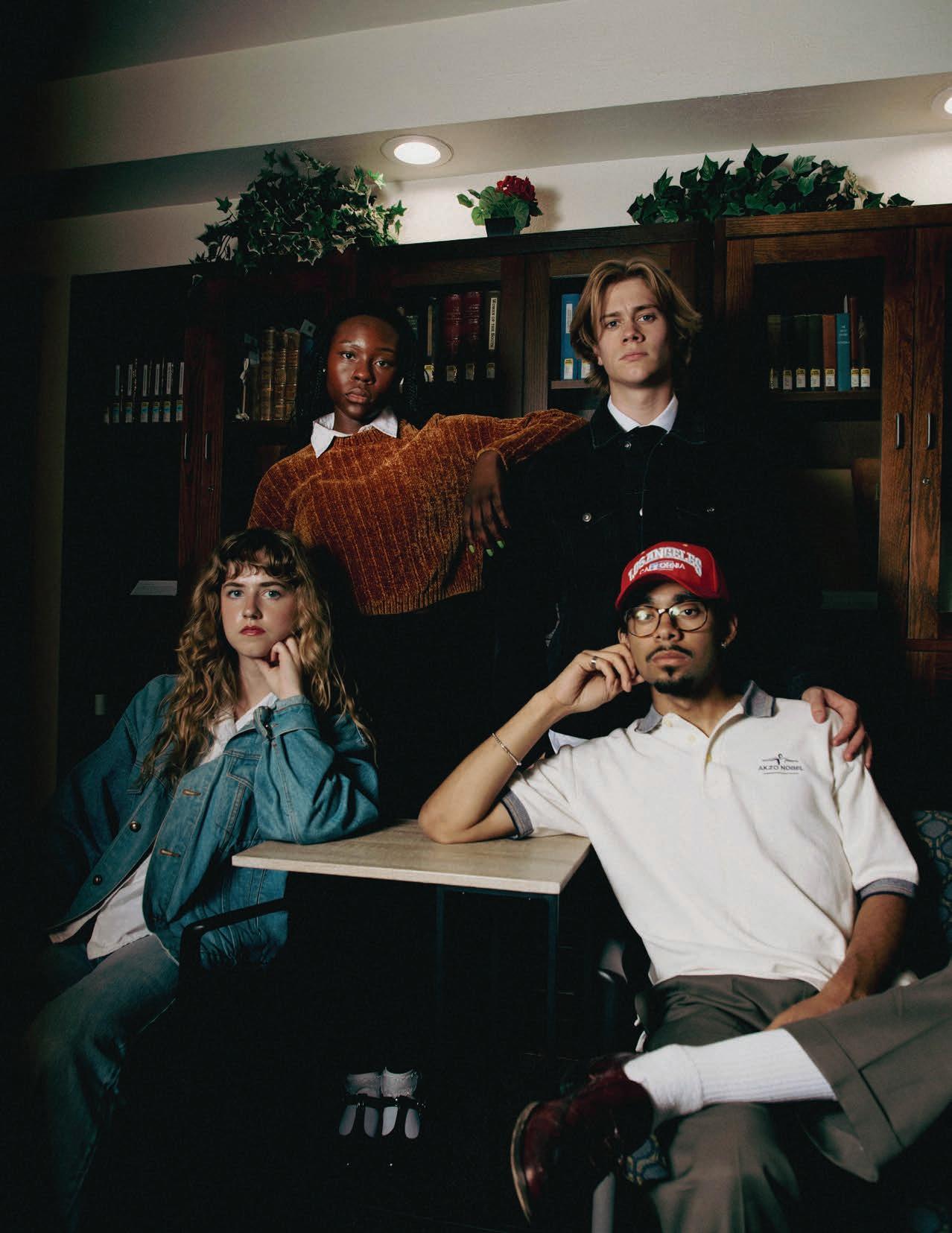
Featured: WHAT HAPPENED TO LAMENTS? ZIPPORAH MARSE EXPLORES THE HISTORY OF WORSHIP MUSIC. TO READ MORE, TURN TO PAGE 25.
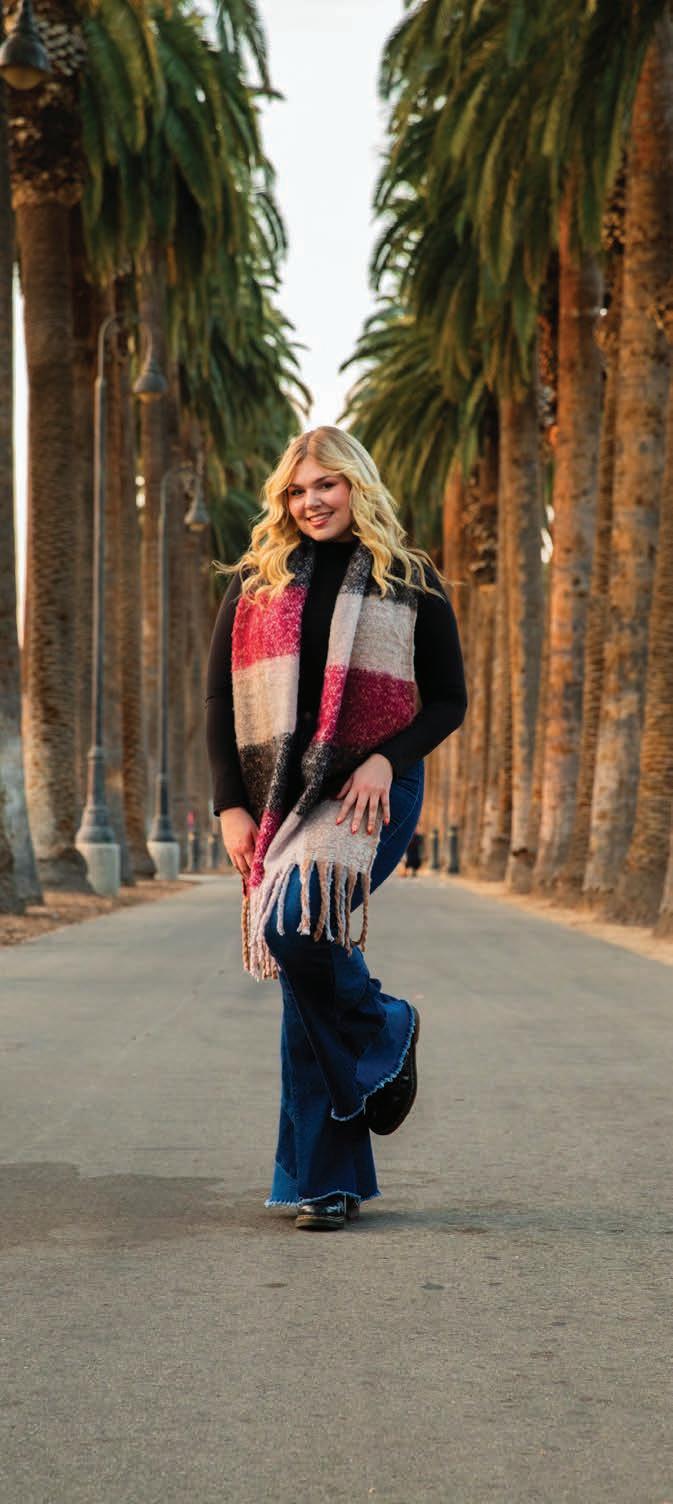
Dear Reader,
Nostalgia is something we all experience at some point. It’s that longing for the past that makes you wish you could revisit a different time or that things could remain unchanged. Movies, TV shows, books, and even random toys or objects can remind us of different periods in our lives, often evoking memories of childhood when everything felt happy and peaceful. That’s what I wanted this magazine to be: a timepiece reflecting both the past and the future. This issue draws inspiration from the magazines we read as kids, such as Tiger Beat, BOP, J-14 and Seventeen. Many of our stories and themes explore how movies, trends and experiences have evolved over time. At the same time, I wanted to share God’s word and His love for each of us throughout these pages. You may recognize me from the past two Angelos Yearbook Editor’s Notes. I must admit, when I was offered the position of editor-in-chief of Pursuit, I was nervous. Creating a magazine is a very different challenge from producing a yearbook. My goal was to create something everyone could enjoy while honoring the Lord. I am incredibly grateful to the students and staff who dedicated long hours and hard work to make this issue something we’re all proud of. I truly couldn’t have done it without each and every one of them. A special thanks goes to Casey Maldonado, our director of student publications, print & online, for answering every call and supporting me through this entire process. I hope you enjoy this journey through time and feel a sense of nostalgia as you read our magazine.
Sincerely,



To the choirmaster. A Psalm of David.
How long, O Lord? Will you forget me forever? How long will you hide your face from me?
How long must I take counsel in my soul and have sorrow in my heart all the day?
How long shall my enemy be exalted over me?
Consider and answer me, O Lord my God; light up my eyes, lest I sleep the sleep of death, lest my enemy say, “I have prevailed over him,” lest my foes rejoice because I am shaken.
But I have trusted in your steadfast love; my heart shall rejoice in your salvation.
I will sing to the Lord, because he has dealt bountifully with me. (ESV)



Egg
What is an egg?


The beginning of life
A chick hatching out of a shell
A source of food in the morning
Yellow and white
Yellow
The yolk
The yolk of God
Take my yolk upon you and I will give you rest
Giving Him all of your burdens
Giving Him all of your stress
Stress


Stress until you crack
Crack
Like an egg
Egg








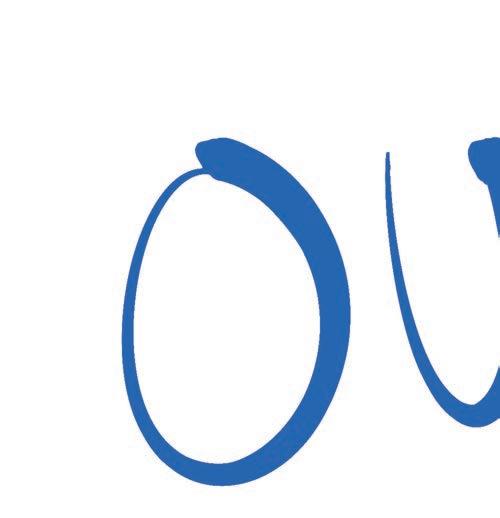




Have you ever wondered who stands on the sidelines at your school’s volleyball tournament or during football games on TV? From high school basketball games to Major League Baseball, athletic trainers are there to provide healthcare for athletes. Whether through physical, mental or spiritual help, athletes rely on athletic trainers to prepare them for everything their sport demands.
Though often confused with personal trainers, athletic trainers are distinct healthcare-certified professionals with specialized training to prevent, diagnose and treat injuries. Jolene Dickert, a professor and clinical coordinator for athletic training, emphasizes this difference. “One of the things that is important to me, having been in the profession for a long time, is that athletic training is healthcare,” she says. “We have a skill set that a lot of people don’t know about, and we can help a wide variety of individuals. Because of the name, everybody thinks, oh, you just work with athletes, but that’s actually not the case. One of the really unique things about athletic training is that, basically, if you’re an active individual, we can help you.”
At CBU, the athletic training program is highly specialized, offering students both professional and personal development opportunities. Dickert explains that ATs see patients every day, allowing for strong
relationships with those they treat, which is a unique aspect of the profession.
For many in the program, like students Nolan Torres and Thomas Ng, the decision to pursue athletic training at CBU stems from the university’s unique approach and values. CBU’s application process emphasizes the relational and spiritual aspects of the field. First-year Master of Science in Athletic Training (MSAT) student Nolan Torres says his interview experience at CBU made him feel supported. Second-year MSAT student Thomas Ng recalls how CBU’s interview process set it apart from other schools by focusing on the applicant’s personality rather than technical aspects alone.


Ng explains, “I remember I was like, ‘Oh man, here we go again,’ expecting another boring interview, but they unexpectedly gave me different interview questions that really asked about me instead of the program. One question specifically was like, ‘What would you do if there was a tiger outside of our door right now?’ And I was like… well, I’d be very worried and scared,” he says. “But they push you toward that realm. Why would you be scared? And I just had to admit, like, I’m a human being… it’s a tiger. It’s scary. And that was it, you have to react like a human being.”
This emphasis on human connection is further reflected in the philosophy of “whole person care” at CBU. The approach goes beyond treating injuries and



















extends to addressing the full well-being of each patient. While “whole person care” is widely discussed within CBU’s program, it isn’t emphasized as much outside the university. Second-year MSAT students Becky Hernandez and Jillian Soma mention they hadn’t encountered the term used with the same depth in other programs.
Hernandez explains the concept with an example: “If Jillian were to come in, and she was my patient, and she has like a meniscus injury in her knee, she’s not just the girl with the meniscus injury. She’s a whole person dealing with a meniscus injury as well as now dealing with being out of her sport, and she’s like halfway through season, and now she can’t play anymore. How is that affecting her? Physically, mentally emotionally, like all those parts of it.”
The “whole person care” philosophy shapes how students learn to treat injuries while considering the emotional and psychological aspects that affect recovery. In addition to the one-on-one mentorship offered to each first-year student, CBU’s program encourages collaboration through seminars that include students from other healthcare disciplines like nursing and physical therapy.
“We have a lot of seminars we go to with other programs at CBU,” Hernandez says. Recently, students participated in a collaborative event where they worked with groups from various healthcare disciplines to





















address a hypothetical case study. “Everybody all learns what we do, our scope, where things cross, but then also the lines we shouldn’t cross. We learn that we’re all on the same team, but we have different jobs,” she says.
Such experiences are invaluable in helping athletic training students understand their role within a larger healthcare team, underscoring that while they are highly specialized in working with active individuals, they are part of a broader healthcare network.

CBU’s athletic training program also provides hands-on experience through clinical placements, where students work directly with licensed ATs in real-world environments. These placements can be nearby, allowing students to continue attending classes, or immersive, involving up to ten weeks in a clinical setting without classes. Dickert oversees these placements, matching students with opportunities that align with their specific career interests. The placements are tailored to suit students’ interests, allowing them to work in diverse settings nationwide. “I’ve had students as far as North Carolina,” Dickert says. “I had a student work with the Louisville Ballet in Kentucky, and we’ve had students at Stanford University, UCLA, University of North Carolina… So dependent upon what setting they’re interested in, that allows us the opportunity to do that, to send them there.”
These placements are crucial, as they allow

AT students to apply their knowledge in the field and develop connections with patients and fellow professionals. Torres describes his experience working under Michele Vasquez, assistant athletic director for sports medicine, as formative.
“I was fortunate enough to work with cross country and I got to go with them to their retreat up in Big Bear that they do every year. I got to really get that experience of bonding with the athletes themselves personally,” he says. Torres adds that these experiences helped him connect with the athletes, providing them with a safe, supportive space for healthcare. Nolan shares that the connection he formed with his patients led to them only wanting to go to the clinic when they knew he would be there, leading to what they called “National Nolan Day,” much to his dismay.






Athletic trainers provide essential care to active individuals across different sports and settings, working to support not just the physical but also the emotional and mental health of those they serve. At CBU, this support is elevated by spiritual integration and a focus on whole-person care, providing students with a comprehensive education that equips them to treat patients with empathy and professionalism.
CBU’s approach to athletic training creates professionals who understand the importance of not only addressing injuries but also supporting athletes as people. So, next time you’re at a sporting event,


sidelines—they’re there to provide support in ways both seen and unseen, ensuring athletes are healthy and ready



















































































Screens have taken a toll on the day to day lives of college students.
In today’s world, screens are an inseparable part of daily life. Since the early 2000s, screen time has skyrocketed, drastically changing how we think, learn, and connect. The rise of digital communication, social media, and smartphones has reshaped cognitive and social interactions. Attention spans have shortened, and relationship-building has shifted toward surface-level connections. Both children and adults have experienced significant changes in attention, memory, and problemsolving skills as screen time has increased. The fastpaced, fragmented nature of online communication often promotes multitasking and shorter attention spans, making it harder for people to focus during longer, more complex discussions. These shifts reveal that technology offers many advantages but also challenges our capacity for meaningful engagement and deep thinking in a screen-centric society.
Screen time has become a dominant force in shaping cognitive functions and social behaviors. Dr. Erin Smith, professor of psychology, discusses the effects of screen time on attention, memory, and problem-solving. “Technology, including screen time, cell phones, and the internet, is just another tool—like books were in the past. For example, before the invention of the printing press, people had to memorize scripture because they didn’t have access to personal Bibles. Once the printing press made Bibles widely available, people learned less scripture because they could now read it anytime.” In this sense, technology extends our cognitive abilities by allowing us to outsource tasks like memory to digital devices, altering how we think and learn.
The type of screen activity also plays a crucial role in how it impacts the brain. Dr. Smith notes that different screen activities, such as social media, gaming, and educational content, affect the brain in distinct ways.
“Attention spans have generally decreased over time,
partly due to the structure of the internet and features like infinite scroll,” she says. This has led to more superficial engagement, making it harder for people to focus deeply. However, this same technology has broadened access to information, which can enhance problem-solving abilities.
Dr. Smith also highlights an essential social shift linked to technology use. “We’ve become much less comfortable with boredom because we can always pull out our phones for entertainment,” she says. Boredom, however, is essential for creativity and cognitive development, providing the mental space needed for imaginative thinking.
Multitasking, common with smartphones, has made our brains more efficient at performing routine tasks. “The purpose of memory isn’t just to remember the past but to predict the future,” she says. By automating frequent tasks, the brain conserves energy for more complex processes. Dr. Smith also emphasizes the educational benefits of high-quality content for children. “Shows like Sesame Street and Daniel Tiger help children, particularly those from low-income backgrounds, develop literacy and emotional skills critical for educational readiness,” she says. While screen time presents challenges, it also offers opportunities for learning and growth.
As screen time continues to increase, its impact on interpersonal and community-level communication becomes undeniable. Michael Marse, assistant professor of communication arts, explains that our effectiveness in face-to-face interactions has declined due to the reliance on digital communication. “We’re not good interpersonally,” Marse says. “When we measure communication competence—asking, ‘When I say things, do people understand what I’m trying to say?’—the answer is less.” This decline has real-world implications, as even critical conversations, such as asking someone on a date or delivering difficult news, are more challenging for younger generations who grew up immersed in screen-based communication.
Marse notes that while younger generations are more media-savvy and learned to brand themselves early on, this digital-first approach to communication comes with emotional drawbacks. “They were their own brand in seventh grade, which is not amazing,” he says, pointing out how the pressure of self-promotion is ingrained, even in casual online interactions. Younger generations, aware of social media’s public nature, view themselves as brands, which can sometimes overshadow deeper personal expression.
This shift has transformed how relationships begin and evolve. “We don’t share anymore. Romantic relationships start with superficial things,” Marse says. Instead of meaningful conversations about life goals, young adults focus more on curated online personas and influencer-driven values. As a result, milestones like marriage and first dates are delayed as young people navigate a world where deeper connections are increasingly rare.
To gain a personal perspective on how screen time affects younger generations, Denise Hernandez, freshman psychology major, shares her experiences. Hernandez explains that screen time has significantly impacted her ability to focus on academic tasks. “Whenever I’m doing homework and I see a notification, it’s instinct to check it,” she says, emphasizing how constant distractions hinder her ability to complete assignments efficiently.
In addition to affecting focus, Hernandez discusses how screen time has altered her sleep patterns. “I noticed that I go to sleep later because I want to have time to be on my phone,” she says, explaining that late-night scrolling often results in less sleep. This pattern is common among students who use their phones to relax but end up sacrificing valuable rest.
Hernandez also acknowledges the role of
multitasking with multiple screens. Whether watching TV or scrolling through social media, she frequently juggles different media but admits it often reduces her ability to focus on longer tasks. Apps like TikTok, designed for short bursts of content, make it harder to maintain concentration.
Social interactions have also shifted for Hernandez. “Seeing how people act on shows or media affects how I talk and interact with people,” she says. Face-to-face interactions have become more challenging after prolonged digital exposure, echoing Professor Marse’s point that younger generations struggle to engage in deeper conversations.
From a mental health standpoint, Hernandez expresses concern about screen time’s negative impacts. “Sometimes the things I see on social media can be so violent or cruel,” she says, highlighting the emotional toll that constant exposure to distressing content can have.
While screens have undeniably revolutionized lives by providing access to vast information and facilitating communication, they also pose significant challenges to cognitive functions and social behaviors. Insights from experts like Dr. Erin Smith and Michael Marse highlight a complex landscape where increased screen time contributes to shortened attention spans, altered memory functions, and superficial relationships. As exemplified by Denise Hernandez’s experiences, digital media affects academic focus, sleep patterns, and interpersonal interactions in ways that may hinder genuine connection.
As we navigate this screen-centric society, striking a balance that leverages technology’s benefits while fostering deeper, more meaningful engagement is crucial. Recognizing screen time’s dual nature can empower us to adapt our habits, ensuring we cultivate cognitive depth and rich social ties in an increasingly digital world.
“We’ve become much less comfortable with boredom because we can always pull out

our phones for entertainment,”
- Dr. Erin Smith



What S son Are you? “ ”

HOW DO YOU FEEL ABOUT CHANGE?
A. I FEEL INDIFFERENT TO IT
B. IT IS SOMETHING TO LOOK FORWARD TO
C. I PREFER CONSISTANCY AND FAMILAR ROUTINES
D. I ENJOY IT AND WELCOME IT
PICK A DECORATION
A. CANDLE
B. FAIRY LIGHTS
C. PILLOWS
D. PLANTS



WHICH BEST DESCRIBES YOU?
A. CALM AND RESILIENT
B. OBSERVANT AND CREATIVE


C. OPTIMISTIC AND WELCOMING
D. WARM AND ADVENTUROUS
PICK AN ELEMENT
A. AIR
B. FIRE
C. WATER
D. EARTH
CHOOSE AN ACTIVITY
A. A NIGHT IN


B. TRYING NEW RESTAURANTS
C. GOING OUT WITH FRIENDS
D. SPENDING TIME OUTDOORS








































You are welcoming and you inspire others with your optimistic personality! You find comfort in the outdoors and enjoy adventures with friends. you are caring and are not afraid to lend a hand whenever it’s needed.



You are calm and reliable!
You enjoy your relaxing time and find comfort being indoors. However, you still enjoy making meaningful connections with others and you appreciate spending time with friends and family. People really enjot your company ad admire your unique personality.





































You are resilient and very observant. You enjoy and pay attention to the little things. You are open to change, but also appreciate having a routine. Your friends and family seek you when they need comfort or advice.









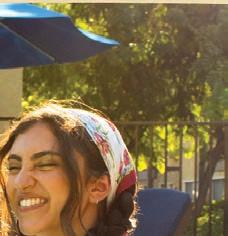
















































You are energetic and warm! People enjoy being around you and you inspire others with your positive energy. You enjoy relaxing and finding time throughout your day to recharge. People appreciate your kindness and thoughtfulness.





In the book of Psalms, there’s a powerful verse that reads, “My God, my God, why have you forsaken me? Why are you so far from saving me, so far from my cries of anguish?” This is Psalm 22, a lament echoed in the New Testament when Jesus is on the cross. For many Christians, this verse is challenging as it seems to convey a somewhat negative view of God. Understanding why such laments are included can be difficult, especially as lament has largely disappeared from modern church and worship culture.
Over the summer, Grace Akintimoye, a junior architecture major, took California Baptist University’s Overview of the Bible class, where she was introduced to biblical laments in depth. Though familiar with the term and the book of Lamentations, she didn’t know much beyond that. The class explored laments in the Bible, and













Akintimoye recalled being struck by some of the Psalms. “I was like, woah, David is literally shaking his fist at the sky. Yeah, it really surprised me,” she says. Many Christians today have never fully explored laments—whether in church, with friends, or individually—and may lack a strong definition of what a lament is, let alone understand its importance in a spiritual journey.
Dr. Jeffrey Mooney, professor of Old Testament, describes biblical laments as “singing to God from dark places.” The book of Psalms is filled with laments—about 40% of the Psalms fall into this category—confirming that lamenting was a common practice in the Old Testament. “I think laments are these high points of genuine faith,” Dr. Mooney explains. “The singer doesn’t see light at the end of the tunnel yet still sings, complains, weeps, and questions God, but with great hope in God and complete confidence in His goodness.”


singing to God from dark places. “







The initial shock of reading a lament like Psalm 22 can ease when the reader reaches verses such as, “Yet you are holy, enthroned on the praises of Israel.” This faith-driven hope is a crucial part of laments. Fredo Ramos, online pastor at Sandals Church, specifies that “laments are different from complaining.”
“A complaint is more of an accusation of [God’s] character. That’s not what this is; this is appealing to His character,” Ramos says.
“It’s more like, ‘God, you are a God of justice, you don’t like wickedness, so please deal with this. We look to you for deliverance, for your righteousness, and the day when you’ll address this.’” Ramos defines lament as a prayer or praise appealing to God’s character “in spite of current suffering.”




















√ Hide not your face from your servant, for I am in distress; make haste to answer me. “ “























Given these definitions, it’s understandable why someone like Akintimoye might see certain lamenting Psalms, like Psalm 69:17, as rude or disrespectful without context: “Hide not your face from your servant, for I am in distress; make haste to answer me.” For many modern Christians, the difficulty of reading such passages can reflect the current state of worship culture.
In 2023, Dr. Mooney conducted a study on the top 20 worship songs from the past decade (2013-2023), examining 200 songs for lament themes. While he found some lament-like language, none were true laments. Churches and mainstream Christian music artists are simply not engaging in the lament culture found in the Old Testament. Why is that?
“Evangelical Christianity often falls in love with success and describes the Christian life as one of success,” Ramos says. “I don’t think we’ve done a healthy job at talking about how even a life of obedience will have immense seasons of pain and hardship.” He adds that many Christians struggle to discuss hardship except as consequences for sin. “Which is connected, no doubt, but
sometimes there’s suffering that is just… unexplainable.”
Both Ramos and Dr. Mooney explain that the church’s goal to appeal to a broader, often younger, audience has led pastors and worship leaders to avoid these healthy explorations of suffering. Dr. Mooney points to the tent revival of the 19th and 20th centuries, where pastors would evangelize to large audiences. “Loads of people were saved during that period,” he says, “but it changed how local churches thought of themselves.” While laments remained popular into the 1800s, this widespread evangelization marked the beginning of their decline in worship.
Akintimoye points out that this selective focus on “good times” in worship can be harmful. “I mean, no wonder the youth is leaving the church. If you’re only talking about the good times in worship, yes, He’s great, but it doesn’t mean there’s not suffering. Paul says he’s fought the good fight; he talks about what he had to fight. If we’re not talking about that stuff, it’s like we don’t have any battles. If we don’t talk about it, then everyone’s gonna think they’re the only ones fighting.”
√If we don’t talk about it, then everyone’s gonna think they’re the only ones fighting. “

“


Lamenting goes beyond verbalizing struggles; it offers an opportunity to connect with others and with oneself. Ramos says that’s why he reads from Psalms daily. “If someone asks, ‘Hey Fredo, how are you doing?’ I don’t know what to say. I struggle to be aware of how I am, I struggle to locate myself emotionally sometimes, so I read the Psalms as a window into my soul.” He describes laments as working like a mall directory with a “You Are Here” marker. Not only can laments help you find yourself, but they also help you empathize with others. Ramos explains that reading Psalms that don’t resonate with his current experience prepares him to interact with people facing different struggles. “It really softens my heart towards those who are in pain around me,” he says.
Ramos believes laments have the power to connect Christians with others and themselves, while Mooney sees them as words of genuine faith. Laments aren’t merely relics of the past. Akintimoye, raised in the church, notes that laments exist in modern Christian music—just not worship music. “I listen to a lot of stuff,” she says.




“Like, Christian heavy metal, Christian rock, Christian R&B, and when I think about it, I feel like most of that stuff is laments. A lot of these lyrics, they’re really open about struggles and pain, but they’re still Christian; they still uplift God.” She pulls out her phone, finding “OUTSIDE,” a song by Indie Tribe, Mogli the Iceburg, and nobigdyl, where the rapper compares his pain to Jesus’ and wrestles with life’s persistent angst. “So yeah, in CCM (Contemporary Christian Music) that we hear at church during worship, there aren’t many laments, but they definitely exist.”
Laments are a crucial part of Christian life, as seen in the Bible and through human experience with grief and struggle. While laments are disappearing from today’s mainstream Christian practices, they aren’t entirely lost. Younger Christians are still exploring and embracing lament culture, even if differently and less prominently than in the past. As a new generation takes up these expressions of faith, perhaps a brighter spotlight will fall on the Bible’s “You Are Here” marker.















Relief
By: Aaliyah Durley
Relief
Courses through me
Like a tidal wave
A wind tunnel
Drowning out every other voice
Every other sound, Emotion
That threatens to take it out
Take a minute
Inhale
Remember
Relief










Your friends huddle on the couch, popcorn ready and candy in hand, prepared for a fun movie night.
What are you watching?
As streaming services have taken over the film industry, viewers are presented with thousands of options every time they turn on the TV. Many have become victims of “scrolling fatigue.” With so many choices, it’s hard to pick, and by the time you decide, the movie doesn’t seem interesting anymore.
Every “perfect movie night” is different, but how often do we rewatch the same films? Movies like “Mean Girls,” “Ferris Bueller’s Day Off” and “To All the Boys I’ve Loved Before” are staples of the “movie night in.” The comingof-age story has transcended the test of time through these films and so many others.
So, why does it feel like we’re not making them anymore?
The quintessential mid-budget coming-of-age story has been a hallmark of each generation since the 1950s. However, with the rising popularity of high-budget films like the Marvel franchise and action-based blockbusters such as the Mission: Impossible franchise or even the sequel to “Top Gun” (2022), simple mid-budget films seem to have gone out of style. One potential reason is the impact of the COVID-19 pandemic, which delivered a significant blow to studios and theaters. Revenues steadily decreasing have led to widespread closures across the United States.
“We’ve made many improvements to draw people in, but it’s not the same since the pandemic,” says a manager at Dos Lagos Cinema in South Corona. The theater recently underwent major renovations, adding recliner seating to each of its 15 cinemas. The improvements have decreased the capacity of each room and raised ticket prices. “We still have quite the turnout for the bigger movies, but we’re not regularly selling every seat.” The increase in ticket prices and the pandemic’s effects have pushed studios toward simultaneous—or even exclusive—direct-to-streaming releases. In an era dominated by remakes, sequels and comic book movies, smaller stories often don’t make the cut.
These trends have given rise to the coming-of-age TV series and high-budget teen films such as The Summer I Turned Pretty (2022) to XO, Kitty (2023), and Uglies (2024). While some of these shows and films gain traction and popularity, surveys show these shows aren’t as popular with audiences as the production trends would lead us to think. In a recent study polling 100 students at California Baptist University, approximately 60% of students expressed their desire for more unique movies than new
TV series in the next few years.
Teen films have, of course, been impacted by these trends. The emphasis on higher-budget movies has left audiences with a different type of film than previous decades.
But how do we define the teen movie? Where did this genre come from?
Our story begins in 1955.
The first children of the baby boom are coming of age. During this time of racial, social and political turmoil, young people search for where they fit in society. “The movies” became a common Friday night pastime as teens seek autonomy.
But what was there to watch?
Enter James Dean and Natalie Wood in Nicholas Ray’s “Rebel Without a Cause.” From the very first frame of the film, the message is clear: here’s a story about the realities of troubled teens from the perspective of troubled teens. What did being an outcast as a teenager in the 1950s mean? A story like that had never been told before.
“There are lessons to be learned by watching the adults in the [film] and setting themselves apart from the hypocrisy and the loss of joy that happens when one turns into an adult,” says Dr. Croteau, professor of film studies. She adds, “Teen movies... are based in a real crisis of the Boomers coming of age… the juvenile delinquent film was a big deal in the 1950s. The teen narratives that are baked in that oven move away from the tragic feel of those social problem pictures by the time we get to the late 60s.”
The 1960s see the growing popularity of the “teen beach movie,” a formulaic approach of movie-making that often starred the same set of actors and featured similar simple plotlines. The following decades continue the trends of tragedy and drama, while films like “Grease” (1978) and “American Graffiti” (1973) glamorize teenage life in the ’50s. Dr. Croteau explains, “It takes until the ’80s when you really get a break between the juvenile delinquent genre and the teen genre.”
The 1980s gave rise to a new age in cinema. The decade would define adventure movies as we know them today with the conclusion of the original “Star Wars” trilogy (1983), the beginning of “Indiana Jones” (1981) and many others. At the same time, the teen film had grown into its own category.
Dr. Croteau discussed the cultural significance and shift in this genre of films, stating, “The hypocrisy of adults and really strong peer pressure narratives which pulls right through from the delinquent films. It’s an extension of the social problem film.”
John Hughes’ films, including “Sixteen Candles”

(1984), “Ferris Bueller’s Day Off” (1986), and “Pretty in Pink” (1986), became iconic examples of the coming-ofage genre, introducing Hollywood to the “Brat Pack”— Emilio Estevez, Molly Ringwald, Rob Lowe, Ally Sheedy, and Andrew McCarthy. These films, which blended teen empowerment with classic themes of outcasts and parentchild relationships, helped define the 1980s as a landmark era for teen cinema. While they addressed serious social issues, the decade’s films often embraced a more feel-good tone, setting them apart from previous generations.
“[In John Hughes’ films,] the teens really are winning. It’s the teen’s world.” Dr. Croteau states. Where the films of previous generations would often end in tragedy, the new generation would end in victory. Through this, the comingof-age films became an iconic part of 1980s cinema. Their relatable themes help these films remain iconic to this day.
While the 1980s focused on a predominantly male perspective with limited female led narratives, the 1990s would turn this dynamic on its head. Young women and their stories would be at the center of this new decade of teen cinema. This shift would start with “Say Anything” (1989).
Dr. Croteau says, “In this type of film, the story focuses on a young woman who is high achieving. She privileges her future above all else. The man’s ultimate destiny is her. Her ultimate destiny is one of her choosing.” After giving examples such as “Say Anything” or “10 Things I Hate About You” (1999), she adds, “The 1990s are focusing, for the first time perhaps, on women’s role in society being larger than what the 1980s allowed us to envision.”
The 1990s to early 2000s would further set the teen film as a category of its own, following new trends and ideas in the industry. With feminist ideologies being further discussed in these films came the introduction of the “mean girl” trope. This trend began in the late ’80s but would be further explored in the following decades. Dr. Croteau
comments on the appeal of “Mean Girls” (2004) giving a reason as to why the film still appeals to modern audiences.
“I think there is a certain type of power these young women have in the ‘Mean Girl’ movie. There’s something to be said about the appeal of being mean. Movies give you permission to laugh at things you really shouldn’t,” explains Dr. Croteau.
The “mean girl” trope faded quickly, and by the 2010s, book-to-film adaptations like “The Fault in Our Stars” (2014), “The Hunger Games” (2012), and “Twilight” (2008) dominated. Today, remakes and adaptations, such as “Barbie “(2023), “Wicked” (2024), and “Moana 2” (2024), are common in cinema. The past five years have seen a surge of sequels and reboots, including a “Mean Girls” remake (2024), while mid-budget films are mostly streaming exclusives. Audiences, tired of repetition, are growing bored with the trend of sequels, remakes, and action films.
When asked what they would like to see in the future of entertainment, one student comments, “I would like to see more stories that leave me feeling satisfied and not like I just wasted my time. [We need more] stories that inspire with both good times and bad, stories that make me forget the real world instead of shoving the stupidity [and] politics of the world down my throat.”
More than 50% of students polled agreed they are tired of remake culture. Young audiences are hungry for something new. Many are calling for a return to classic romantic comedies and more timeless films.
Now, the stories of tomorrow must be written today. The years to come will give rise to new narratives, with new stars and new ideas, and those stories are ours to create. From James Dean, to Lara Jean, to the ‘80s and beyond, coming-of-age stories continue to be a staple in cinema. Only time will tell what masterpieces will be created.
























(Lefttoright):Seniorliberalstudiesmajor MorganJackson,seniorelementaryeducation majorEliseBurt,seniorbuisnessadministration majorMcKinleyReynolds,andseniorbiology majorKaylieVerblewatchamovie.












The college experience is full of opportunities. Students further their education, cultivate friendships, and try new things, all while striving to become the best versions of themselves. Yet, alongside these opportunities come the realities of stress, packed schedules, and financial challenges. Finding time to unwind and connect with friends gets harder as the semester intensifies. So, where do you go to escape? What’s there to do when you need a break from campus?
California Baptist University’s location in the heart of Southern California places it a perfect distance from the mountains, desert, and beach. It’s also just 33 miles from the Disneyland Resort, famously known as “The Happiest Place on Earth.” Whether students invest in a Disney pass or not, the sprawling property offers plenty of ways to escape campus life and bring a bit of Disney magic to the college experience.
Since 2017, the price of a single-day, single-park Disneyland ticket has jumped nearly 50%. Annual pass prices have risen 33% and now include changes like required reservations and penalties for no-shows. Parking prices have doubled, and more increases are expected. Passes also have more blackout dates. The lowest Magic Key costs $599 (compared to $419 in early 2020), while the highest reaches $1,749 ($1,449 in 2020). With these increases, students must ask if Disney is worth the investment.


Joshua Ackley, junior aviation flight major, believes it is. “It’s very simple. It’s worth it to me, especially the pass prices, because of how much I enjoy going and the memories I make. It brings me the same amount of happiness no matter how many times I go. Others might not feel the same way simply because it’s not what brings them happiness,” he says.
Even with rising costs, Disney remains an option for college students to escape everyday stress. The cheaper pass options allow access most weeknights, making it easy to visit the park for a few hours as a reward after a tough exam.
The “Happiest Place on Earth” appeals to a wide variety of visitors. Despite high prices, the parks remain busy. Some return for nostalgia, while others experience the magic for the first time. Disney caters to both children and the young at heart, drawing people from all walks of life to its gates.
Bill, food service manager from Huntington Beach, has worked at Disneyland for over nine years. Though Disney’s policy prevents him from sharing his full name, he enthusiastically shares his experiences. “You never know who you’ll get to
interact with, and that makes my job really special,” he says. “Sometimes, you’re with folks here weekly, and other times, they haven’t been here in five years and are rediscovering the magic. Those conversations are very different, but no matter the situation, it’s magical to see how excited families get. I think it’s the magic we create that makes guests want to come back.”
Elise Burt, senior elementary education major, shares a similar sentiment. “I love going to Disney because it reminds me of my childhood,” she says. “I love the magical atmosphere created throughout the park. As someone who is creative, I really love seeing all the details the workers put into the rides and lands. I choose to return because I feel like each trip is a new experience with new people.”
Perhaps the most magical aspect of Disneyland is the opportunity for connection. The real magic doesn’t come from the castle or the rides but from the people in the park. Whether you’re a cast member, student, first-time guest, or weekly visitor, a new experience awaits every time you step onto Main Street USA. A day at Disney guarantees memories that transcend the cost. Whether it’s nostalgia, escaping the real world, or creating new experiences with friends and family, Disneyland delivers.
Even without a ticket, the Disney Resort offers unique experiences. In addition to its two theme parks, the property features three major hotels and


Downtown Disney, a district “known for its dining, shopping, and live entertainment,” as the tram cheerfully informs guests. This outdoor shopping area captures Disney magic without the price tag, offering live music, diverse dining options, and a signature Disney shopping experience.
For some students, the Disney Resort even becomes a study spot. The Grand Californian Hotel, connecting directly to Disney California Adventure Park, features a beautifully decorated and cozy lobby free and open to the public. With free Wi-Fi, air conditioning, and comfortable seating, the Grand Californian lobby provides a relaxing environment for tourists and students alike. Soft piano covers of Disney tunes play in the background as the fireplace roars year-round.
Samantha Schoeffler, cosmetology graduate from Riverside, uses the Grand Californian as a study space. “I choose The Grand Californian because it’s convenient, and unlike some libraries, it doesn’t close as early to the public, making late-night study sessions more accessible.
It still gives the feeling of being at a library without the restrictions they have. It’s also nice being able to study and then walk to Downtown Disney for a bite to eat or some shopping,” she says.
Other Disney hotels, like the Disneyland Hotel and Pixar Place Hotel, also provide quiet spaces for students. The Pixar Place Hotel’s Sketchpad Cafe offers customizable coffee and cozy seating, ideal for long study sessions.
Schoeffler acknowledges that location plays a role.
“If I lived further away, the drive wouldn’t be worth it because of gas and the fact that libraries are still a great option. But I’m close enough that driving is worth it, especially when I need a quiet environment for cramming on a big project. Plus, it’s cozy, like working at home without the distractions,” she says.
Whether you study in a hotel lobby, shop at Downtown Disney, or visit the parks, the Disneyland Resort has something for everyone. Disney magic thrives in the connections we make and the memories we share.
“I love e ma c atmosph e cr ted roughout e p k. As som ne who is cr ve, I r y love see g l e d a s e work s put to e d d l ds.”
- ELISE BURT
[SENIOR
ELEMENTARY EDUCATION MAJOR























































CHRISTIAN ARTISTS OVERCOME INDUSTRY PRESSURES AND STAY TRUE TO THEIR BELIEFS.
At California Baptist University, the Collinsworth School of Performing Arts offers opportunities for talented students to use their musical gifts to reach audiences in the Christian genre. For students graduating and entering the music industry, staying true to their faith and beliefs can be a significant challenge.
Christians often feel pressure to conform to societal norms. The music industry amplifies this pressure, encouraging artists to follow trends that may conflict with values of integrity and morality. Secular music often glorifies partying, promiscuity and substance abuse, leaving young Christian artists vulnerable to compromise or, if they resist, the risk of being sidelined for their convictions.
Jamond McCoy, adjunct professor of music and vocal coordinator for commercial music, draws on his experience in the industry to advise students preparing to enter the field.
“One thing that I’ve learned while over my years in the industry, it’s easy to lose yourself and lose identity and in your gift. So if you’re gifted to play or sing or dance, you

quickly can, if you’re not rooted in who you are, you’ll start to identify as what you’re gifted in,” McCoy says.
The music industry is rarely harmonious. Instead, it presents temptations, compromises and constant pressure from media and social platforms to conform to a world often at odds with Christian values.
“But what I’ve realized is I don’t ever have to conform, because my gift isn’t just who I am, I’m not just a pianist, I’m not just a music director, but I’m also a child of God. And there are some people who forget that you’re a child of God first, and then your gift is what you do, it’s not who you are. And so I’ve had to learn over the years how to say no,” McCoy says.
Christian artists are often confined to the “Christian music” genre, where they are expected to produce songs with religious themes or worship music exclusively. For those aiming to cross over into mainstream genres like pop or rock, balancing faith with secular audience expectations becomes a challenge.
Elliot Harrison, junior studio production major, explains how his band, Funky Ducks, formed as a
response to these challenges. The band, made up of CBU students, aims to create clean, alternative music that stands out in an industry saturated with questionable content.
“It’s kind of grown into this whole thing of a clean alternative for an industry that’s already so full of awful content,” Harrison says. “The whole mission of the band is to be Christians who can infiltrate pop culture and pop music and change the culture in a positive way, more of a Christian way.”
The Funky Ducks began performing at local venues, including the popular Big Mikey G’s coffee shop, with a mission to bring uplifting music to the community and strengthen their relationships within the band.
Despite headlines highlighting moral failings in Hollywood, Sarah Jenkins, sophomore songwriting major, encourages Christians to engage with the industry.
“It’s a crazy industry, especially when a lot of the news coverage of a certain rapper is going around,” Jenkins says. “It’s really easy for Christians to be like, ‘Ooh, I want nothing to do with that, or I don’t want to be part of that.’ But our job is to get in there and show people this
isn’t how it has to be, and there’s a better way, and there’s someone that came here to show us a better way.”
Jenkins acknowledges the difficulties but believes perseverance and offering a better alternative are key.
“I definitely do think there’s gonna be a lot of hardship, but I think at the end of the day, our job is to, like I said, push through that hardship and show people a better alternative to that,” Jenkins says.
Christian artists often face an uphill battle when navigating the mainstream music industry, where the commercialization of fame and success sometimes clashes with the values of faith. While Christian music enjoys a dedicated following, the broader industry tends to sideline religious content, favoring artists who embrace secular themes. This divide creates a stigmatism, with some labeling Christian artists as niche or less marketable compared to their secular counterparts.
“There definitely is this stigmatism around the word Christianity… ‘oh, you’re a Christian. You’re not going to be able to create this art that I want to go for. You’re going to give me some like, like, lower quality, low grade product,’” Harrison says.
He counters this perception, emphasizing the importance of excellence.
“If anything, Christians should be giving up highergrade, quality stuff, because our God is the highest quality,” Harrison says.
Harrison aims to navigate the industry with integrity, standing firm in his faith while engaging with a world that often challenges it.
“That’s kind of my way of doing this in my industry, is I’m going out into this industry full of sinful people, people that do bad things. I’m saying, like, Hey, this is what I’m about. You know, I’m not about any of this,” Harrison says.

The industry’s emphasis on controversy and fame presents ongoing challenges for Christian musicians. Many report pressure to soften their messages or adopt secular personas for broader appeal. McCoy advises patience for students entering the field.
“Be patient because it’s easy to get hung up,” McCoy says. “It just takes time, not only to be known in the field, but to also build those relationships.”
Despite the obstacles, patience and determination remain essential for those who want to succeed without compromising their beliefs.
“You got this. Don’t doubt, don’t doubt the gift, your gift will make room for you, trust,” McCoy says.
As students prepare to enter a competitive and conflicting industry, they remain committed to using their talents to spread a positive message. In a world that often values fame over integrity, their journey reflects the belief that authenticity and dedication can make a lasting impact.
“If anything, Christianity being a part of my life helps me stay authentic and honest through my music. The same goes for Elliot’s band. Staying true to ourselves is right under honoring God on our priority list,” Jenkins says.
Through patience and perseverance, they hope to reshape the music scene while staying true to their faith.






“For everything there is a season, and a time for every matter under heaven: a time to be born, and a time to die; a time to plant, and a time to uproot; a time to kill, and a time to heal; a time to tear down, and a time to build up; a time to weep, and a time to laugh; a time to mourn, and a time to dance; a time to scatter stones, and a time to gather them; a time to embrace, and a time to refrain from embracing; a time to search, and a time to give up; a time to keep, and a time to discard; a time to tear, and a time to mend; a time to be silent, and a time to speak; a time to love, and a time to hate; a time for war, and a time for peace.” — Ecclesiastes 3:1-8 (NIV)


































The Bible acknowledges the different seasons of life. As seen in Ecclesiastes 3:1-8, there is a time for every experience and emotion. God acknowledges, understands, and empathizes with all of our experiences and feelings. Although we often face seasons we’d rather avoid, God remains with us through them all. It can be easy for emotions or situations to take over; however, we can turn to God’s Word for truth during those moments. Dr. Sylvie Raquel, biblical studies professor at California Baptist University, shares guidance on seeking God and His Word in all life’s seasons.
“God’s Word is eternal, and He never changes,” Dr. Raquel says. In a world filled with grief, uncertainty, and fear, where everything can feel unpredictable—especially when things are out of our control—we can rely on God as a constant. Dr. Raquel offers insights on where to turn in the Bible for different seasons of life.


Grief is a deeply personal and often overwhelming experience. It’s a natural response to losing someone or something significant, whether a loved one, relationship, or opportunity. Each of us feels grief differently and faces unique forms of it. One passage to turn to is John 11:35, where we read that “Jesus wept.” Dr. Raquel encourages reading this passage to see Jesus’s empathy in moments of grief. “Jesus was a man of sorrow; He knew grief,” Dr. Raquel explains. In such isolating times, it’s comforting to know that God is always by our side.

“Jesus wept.” — John 11:35 (NIV)





a way to express thankfulness to God. Dr. Raquel points us towards Psalm 34, where we can read about exalting the Lord. It also emphasizes the themes of gratitude, trust, and assurance that God delivers.
“I will extol the Lord at all times; his praise will always be on my lips.”
— Psalm 34:1 (NIV)












release our worries.
“Trust in the Lord with all your heart and lean not on your own understanding; in all your ways submit to him, and he will make your paths straight.”
— Proverbs 3:5-6 (NIV)








As we navigate school and work, it’s essential to find time for rest. Burnout can be difficult to handle, especially when responsibilities keep piling up. Yet, God encourages rest. Dr. Raquel references Exodus 20:8-10, which discusses the importance of balance between work, rest, and worship. God commands His people to set aside a day each week for rest, reminding us that even when rest feels elusive, God provides peace.
“Remember the Sabbath day by keeping it holy. Six days you shall labor and do all your work, but the seventh day is a Sabbath to the Lord your God. On it you shall not do any work, neither you, nor your son or daughter, nor your male or female servant, nor your animals, nor any foreigner residing in your towns.”
— Exodus 20:8-10 (NIV)




A Look Into the Origins of CBU’s Latino Student Union and the Departure of the Beloved President.
For first-generation students, stepping onto a university campus for the first time can bring an overwhelming sense of pride and uncertainty. They navigate uncharted territory for themselves, their families and their cultures. This is the case for senior interior design major Kimberly Roman. Despite her uncertainty, she arrives determined to share her culture with others and build a community among fellow Latino students.
Toward the end of her freshman year, Roman decides to take the initiative to become a founding member of the Latino Student Union (LSU), creating a space where Latino students can find belonging. By the start of her sophomore year, the club is approved, and LSU takes off.
Roman is a founding member and the current president of LSU. She is a senior majoring in interior design. Raised in a Mexican household, her father is from Acapulco, and her mother is from Zacatecas. Roman is no stranger to immersing herself in different cultures, having lived in three countries throughout her life.
Born in the United States, Roman moved to Mexico immediately after birth. Three years later, her family relocated to the Dominican Republic, where she lived for 12 years. She then returned to Mexico before moving back to the U.S. toward the end of high school. While searching for a four-
year university, she discovered California Baptist University (CBU) for its interior design program and its proximity to home. “I wanted to be able to stay with my mom and brothers,” Roman recalls, reflecting on the search for a school that balanced her academic goals, family needs and commute as a first-generation student. Roman ultimately committed to CBU to pursue her dream of becoming an interior designer.
As Roman’s time at CBU winds down, she reflects on the learning experience LSU has given her. In her freshman year, as she navigated the campus and balanced classes, she thought about her culture and community. Since high school, Roman has felt the difference between the communityoriented life she grew up with in the Dominican Republic and what she encountered in the U.S. “Over there, it was all about community, all about family, doing everything together and collaborating. Here, it’s a way different perspective of life,” Roman says. Though excited about CBU and her major, she missed the diversity and representation of cultures she had grown up witnessing.
“Coming from a heavy Hispanic and Latino background, I always saw a little bit of everything: Venezuelans, Hondurans,” Roman says. By the end of her freshman year, she still had not found a space to connect with other Latino students and felt compelled to create one. According to CBU’s

institutional data, Hispanic/Latino students make up 42% of the student body, compared to 30.2% Caucasian, 7.3% African American and 6.3% Asian. While Latino students are the majority at CBU, their resources and spaces are still growing to match their representation. LSU is a key part of this expansion.
Roman’s search for community and representation motivates her to co-found LSU. “Starting was hard, a lot of people said that no one had tried to do this before,” Roman says. Despite doubts, she moves forward, completing CBU’s club requirements with help from friends and peers. Once LSU is established, it only needs interest from students. More than 25 members are required to keep a club active, which initially concerned LSU, but student interest quickly erased that worry.
Roman notes LSU now averages about 200 sign-ups annually. “It really hasn’t been a struggle. I think my fear was more about keeping people engaged and wanting to come back,” she says.
Roman’s role as president has earned her recognition for the club’s rapid growth, but she prefers to focus on the community LSU provides.
Sophomore pre-nursing major Evelyn Aguirre joined LSU this year and praises its contributions. “LSU provides a great sense of community here at CBU. We want our members to feel like they can depend on us and talk to us,” Aguirre says. She also credits Roman’s leadership, noting, “She is always willing to listen and collaborate with others.”

don’t do it for your personal benefit, do it for the benefit of everybody else, and how are you serving God. “ “

Roman emphasizes that her leadership feels natural. “Doing this and connecting with people just comes so naturally; it is not something out of the ordinary for me, so this has just felt like I’m hanging out with friends and supporting them,” Roman says. She is also deeply grateful to her mentor, Dr. Noemi Hernandez Alexander. “Dr. Noemi has been a blessing; I really don’t know what I would do without her,” she says.
Dr. Alexander, professor of political science and public administration, is LSU’s founding advisor. She has worked closely with Roman and LSU Vice President Johari Jauregui, senior journalism & new media major, forming meaningful relationships with them. As a first-generation student herself, Dr. Alexander relates to Roman’s journey. During her first year at California State University Long Beach, she joined LSU for similar reasons. “It was the first time in my life that I experienced being around students who had the same aspirations as I did, had a similar background as I did, and we had something else in common—we did not know how to navigate college,”
Dr. Alexander says.
At CBU, Dr. Alexander sees LSU as part of a larger mission. “We are a Great Commission university. We need to go out, but also we need to recognize that the nations are sitting in our classrooms, and we have an
opportunity to fulfill the Great Commission by being culturally competent,” she says.
Although LSU was created to serve Latino students, its community and culture have reached non-Latino students as well. Dr. Alexander praises Roman’s leadership. “I have been blessed to have a front seat to Kimberly’s growth as a leader. She is confident, she is organized, and she collaborates well with others. I know she will continue to do great things in her life and for the community,” she says.
As Roman finishes her last year at CBU, she reflects on how faith has guided her work. “CBU has really shaped the way I approach things, like don’t do it for your personal benefit; do it for the benefit of everybody else, and how are you serving God. LSU is fruit from that,” Roman says. She also encourages incoming Latino students to step into leadership roles and make the most of their time at CBU. “I encourage them to get out of their shell, take advantage of the resources and take the initiative to take more leadership roles,” she says.
Roman’s dedication to representation and community remains at the core of LSU and will have a lasting impact on CBU’s campus. Her efforts have created a foundation for future students and left a legacy that extends beyond her time at the university.

By: Tirza Bustrum
I stood in a dangerous place
Hoping I wouldn’t fall
I saw glimpses of his face
As the fire uttered its call I am a prisoner.
I want to be free I am a sinner.
But who could save me?
Tears as red as the flame

Ran down like my doubt
I expected him to blame
To point his finger and shout
“You have sinned! You are wrong!”
He had more than enough reason I was weak, he is strong
And I am guilty of treason!
I held out my hands
I wanted to be altered I gave up my plans
And saw what I offered: A broken heart!
I fell helpless to the floor
It had been shattered apart
Did I have nothing more?

He smiled. Was it possible?
But my hope had been so dim
Didn’t he know I was unredeemable?
But I had given all to him
Not a piece of me was mine
He made it whole, there were no stains
On the heart of his design
And his love is what remains.
Then he asked, calm and steady, “Do you want to live again?”
I thought I lived already
Would it now truly begin?
I thought I’d damaged my heart
Far too much to live
“But this is only the start. You have so much more to give.”



































To the choirmaster. A Psalm of David.
I waited patiently for the Lord; he inclined to me and heard my cry.
He drew me up from the pit of destruction, out of the miry bog, and set my feet upon a rock, making my steps secure.
He put a new song in my mouth, a song of praise to our God. Many will see and fear, and put their trust in the Lord.
Blessed is the man who makes the Lord his trust, who does not turn to the proud, to those who go astray after a lie!

You have multiplied, O Lord my God, your wondrous deeds and your thoughts toward us; none can compare with you! I will proclaim and tell of them, yet they are more than can be told.
In sacrifice and offering you have not delighted, but you have given me an open ear. Burnt offering and sin offering you have not required.
(ESV)


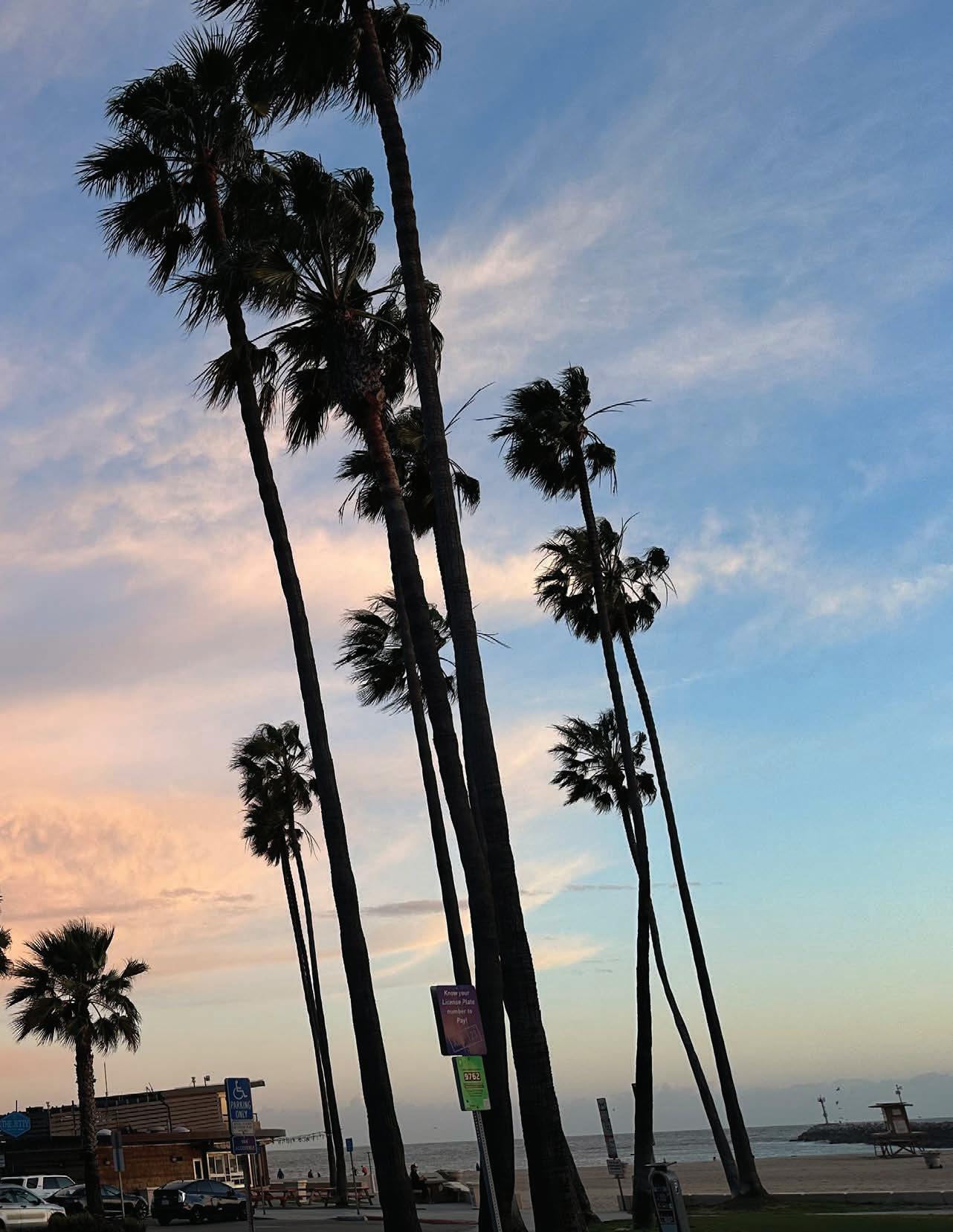






Contributers:



















